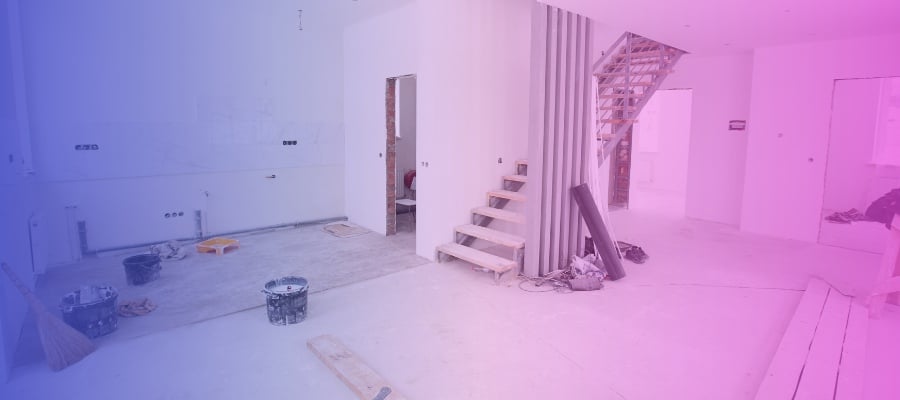
The BRRRR Method: Full Guide and Profit Calculator

BRRRR Definition
BRRRR stands for Buy, Rehab, Rent, Refinance, Repeat. It's a real estate investing strategy in which an investor buys a property, renovates it, rents it out, refinances the property for its new appraised value, and then repeats the process for new properties.
This method allows investors to leverage the equity of one property to purchase additional properties.
Key Steps
- Buy - This is the first step where an investor identifies and purchases a below-market value property needing renovations.
- Rehab - After purchasing the property, it is renovated and improved to increase its market value significantly and meet the standards set by the rental market.
- Rent - Once rehabilitation is complete, the property is rented out to tenants, and this provides a new stream of monthly income for the investor.
- Refinance - After the property has been rented, investors can refinance it. The objective is to find a mortgage that will replace the initial financing for purchasing and rehabilitating the property. The aim is to recover most or all the initial investment.
- Repeat - Once the property has been refinanced and the original investment recouped, the process starts all over again with another property. Thus, the acronym - BRRRR.
Importance

The BRRRR method is an essential strategy in real estate investing for several reasons. Primarily, it allows investors to create a perpetual cycle of investing, essentially maintaining the potential for continuous returns.
Investors buy a property, usually below market value, then increase its worth through repairs and upgrades.
Once it's rehabilitated, they rent it out to gain income. Refinancing with a mortgage allows them to take out the invested capital, which they can use to buy another property and repeat the process.
The BRRRR method is crucial because it provides a structured and efficient method for maximizing return on investment while potentially growing an investor's real estate portfolio.
BRRRR Calculator
We encourage you to use our calculator below if you're interested in exploring this investment strategy. It is a valuable tool for calculating the potential return on investment when using the BRRRR method on a property of interest.
View DealMachine's BRRRR Calculator
Explanation of the BRRRR Method

The Buy, Rehab, Rent, Refinance, Repeat (BRRRR) method is a popular strategy in real estate investing that allows investors to maximize their return on investment by leveraging their existing rental property investments.
Named after the five steps involved in the process, the strategy involves purchasing an under-valued property, improving it through cost-effective rehabilitation, renting it out to tenants at a higher rate, and then refinancing to recover the initial investment capital.
The recovered funds can then be used to repeat the process with new properties.
The primary purpose of the BRRRR strategy is to create a cycle of investment that lets an investor grow their real estate portfolio without needing to input large amounts of their own capital continually.
By enhancing the value of the properties through targeted renovations, investors can increase the rental yield and the property's overall value.
The refinancing step allows real estate investors to extract the equity created through this value increase, which can be reinvested into the next project.
Thus, the BRRRR method provides a self-sustaining model for continual real estate investing.
Examples

Here are three real-world examples:
Example 1:
An investor may buy a run-down property in a good neighborhood at significantly less than market value. After purchasing the property, the investor will rehab the home, updating the kitchen and bathrooms and improving the curb appeal.
Once completed, they will seek to rent the property out, charging fair market rent. Following a successful appraisal, they may refinance the property with a long-term loan and pull out most of their initial investment.
Example 2:
A real estate investor purchases a multi-family property. The property is in dire need of repair, so the investor puts in some sweat equity and possibly hires a contractor to bring the property back to life. After the renovation, the investor rents out all the units, generating a steady income stream.
After a period, they refinance to recoup their initial investment and continue the process with the next property.
Example 3:
An investor spots an excellent deal for a small commercial property. They buy and rehab the property, then lease it to a local business. After the business is thriving and the investor is receiving regular rent payments, they refinance the loan using the increased value of the property.
They now use this surplus capital for the next deal, repeating the process.
In all of these cases, the BRRRR method allows real estate investors to recycle their initial investment across multiple properties, expanding their portfolio without needing enormous amounts of capital.
The BRRRR Method vs. Traditional Real Estate Investing
While similar, the BRRRR method has some key differences compared to traditional real estate investment strategy.
Traditional Real Estate Investing:
Traditional real estate investing typically involves purchasing a property to generate rental income or sell it for a profit.
Here are some characteristics of traditional real estate investing:
- Property Acquisition: Investors identify properties based on various criteria such as location, market trends, cash flow potential, and appreciation prospects. They often rely on their own funds or financing options like mortgages to acquire the property.
- Renovation and Management: The investor may choose to renovate the property to increase its value or make it more appealing to potential tenants or buyers. They then manage the property, handle tenant relations, and address maintenance and repair needs.
- Cash Flow and Appreciation: The primary sources of income in traditional real estate investing are rental payments and property appreciation over time. Investors aim to generate positive cash flow after accounting for expenses such as mortgage payments, property taxes, insurance, and maintenance costs.
- Exit Strategy: Investors may hold the property long term, generating ongoing rental income and benefiting from appreciation. Alternatively, they can sell the property to realize the accumulated equity and potential profits.
Key Differences of BRRRR:
- Risk and Effort: The BRRRR method typically involves more active involvement, including finding distressed properties, managing renovations, and tenant selection. Traditional real estate investing can be less hands-on if investors choose to delegate property management responsibilities.
- Capital Requirements: The BRRRR method often requires less initial capital since a portion can be pulled out through refinancing. Traditional real estate investing may require more upfront capital or access to financing options.
- Cash Flow: The BRRRR method aims to generate positive cash flow by renting out properties. Traditional real estate investing also focuses on cash flow but may prioritize long-term appreciation and potential equity growth. Some may consider this passive income.
Pros and Cons of BRRRR Method

Pros:
- Increased Cash Flow: By purchasing distressed or undervalued properties, rehabilitating them, and renting them out, the BRRRR method aims to generate positive cash flow. This can provide investors with ongoing income and the potential to reinvest in additional properties.
- Forced Appreciation: Through the rehab stage, investors have the opportunity to increase the value of the property significantly. Renovations and improvements can lead to a higher appraised value, allowing investors to build equity and potentially realize appreciation upon refinancing or selling.
- Leverage: The BRRRR method allows investors to leverage their initial investment capital. By refinancing the property based on its increased value, investors can pull out a substantial portion of their initial investment, which can be used to acquire additional properties and accelerate portfolio growth.
- Portfolio Building: The BRRRR method's repetitive nature allows investors to recycle their capital into new properties continually. This approach enables the gradual expansion of a real estate portfolio, providing investors with increased diversification and potential wealth accumulation.
- Risk Mitigation: By purchasing properties below market value and adding value through renovations, investors can reduce the risk associated with overpaying for properties. Additionally, positive cash flow from rental income can help offset holding costs and potential market fluctuations.
Cons:
- Increased Effort and Time: The BRRRR method requires significant hands-on involvement, from identifying distressed properties to overseeing renovations and managing tenants. It can be time-consuming, especially for investors who have other commitments or limited experience in construction and property management.
- Market Risk: Real estate markets can experience fluctuations, and the success of the BRRRR method relies on property values increasing over time. If property values decline or rental demand decreases, it may impact the ability to refinance or generate positive cash flow.
- Renovation Challenges: Rehabilitating properties can come with unforeseen challenges, such as budget overruns, construction delays, or unexpected repairs. Investors must have a solid understanding of construction costs and potential issues to mitigate risks during the rehab process.
- Financing Limitations: Depending on the investor's financial situation, obtaining financing for the acquisition and renovation stages can be challenging. Lenders may have stricter requirements for distressed properties, and investors may need to explore alternative financing options or use their own capital.
- Market Saturation: The BRRRR method's popularity has increased competition for distressed properties in some markets. Finding suitable properties at a discounted price may become more challenging, potentially reducing the availability of attractive investment opportunities.
Alternatives to BRRRR Method

Buy and Hold:
The buy and hold strategy involves purchasing a property with the intention of holding it for an extended period, typically to generate rental income and benefit from long-term appreciation.
Key features of this approach include:
- Property Selection: Focus on properties with strong cash flow potential and growth prospects.
- Property Management: Either self-manage the property or hire a professional property management company to handle day-to-day operations.
- Income Generation: Collect rental income to cover expenses and potentially realize long-term appreciation.
Flipping:
Flipping involves purchasing a property below market value, renovating it quickly, and selling it for a profit. This strategy requires active involvement and a keen eye for identifying undervalued properties.
Key aspects include:
- Property Acquisition: Look for distressed properties that can be purchased at a discounted price.
- Renovations: Make targeted improvements to increase the property's value.
- Timing: Efficiently complete renovations and sell the property to maximize profits.
- Market Research: Stay informed about local market trends to identify profitable flipping opportunities.
REIT Investments:
Real Estate Investment Trusts (REITs) allow investors to own shares in a professionally managed real estate portfolio. This option provides diversification and passive income without the need for direct property ownership.
Key considerations include:
- Investment Flexibility: Choose from various types of REITs, such as residential, commercial, or industrial, based on your investment goals.
- Liquidity: REITs are traded on stock exchanges, allowing investors to buy or sell shares relatively easily.
- Professional Management: REITs are managed by experienced professionals who handle property acquisition, leasing, and maintenance.
Real Estate Crowdfunding:
Investors can pool their funds with others to invest in real estate projects through the use of real estate crowdfunding platforms. This approach offers opportunities to access a broader range of real estate investments with lower capital requirements.
Key features include:
- Diversification: Invest in multiple projects across different locations, property types, and investment strategies.
- Access to Deals: Gain access to properties that may have been challenging to find or invest in individually.
- Risk Management: Evaluate crowdfunding platforms, project details, and the background of sponsors to mitigate risk.
Rental Property Partnerships:
Partnering with other investors or individuals can be an alternative to the BRRRR method. This approach allows you to pool resources, share responsibilities, and invest in properties collectively.
Key considerations include:
- Partnership Agreement: Define roles, responsibilities, and profit-sharing arrangements through a well-structured partnership agreement.
- Complementary Skills: Look for partners with complementary skills or expertise to enhance the investment's success.
- Clear Communication: Establish open and transparent communication channels to ensure effective decision-making and management.
How to Find Distressed Properties
Finding distressed properties for the BRRRR method requires a combination of research, networking, and strategic approaches. Here are some methods you can use to locate a distressed investment property:
Online Listings and Platforms:
Utilize online real estate listings and platforms that specialize in distressed properties.
They provide information on foreclosures, bank-owned properties, and properties sold at auctions.
Real Estate Agents and Wholesalers:
Develop relationships with real estate agents who specialize in investment properties or distressed sales. They may have access to off-market deals or be aware of properties in pre-foreclosure or short-sale situations.
Similarly, wholesale investors can provide leads on distressed properties they have sourced.
Direct Mail and Marketing:
Create targeted direct mail campaigns or marketing materials to reach out to distressed property owners. This can involve sending letters or postcards to owners in pre-foreclosure, tax delinquency, or those with expired listings.
Clearly communicate your intent to purchase and offer solutions to their distressed situation.
Local Government and Public Records:
Research public records, such as tax records, to identify properties with delinquent taxes or liens.
Contact the local government offices responsible for tax collection or property assessments to inquire about distressed properties or upcoming auctions.
Networking and Word of Mouth:
Attend local real estate networking events, join investor groups, and establish connections with other real estate professionals.
Networking can lead to referrals and insights into distressed properties that may not be widely known.
Driving for Dollars:
Physically drive through neighborhoods or target areas looking for signs of distressed properties. Look for signs of neglect, overgrown yards, boarded-up windows, or vacant properties.
Take note of these properties and conduct further research to determine their status.
Online Research and Social Media:
Use online resources and social media platforms to research distressed properties. Explore websites, forums, and social media groups dedicated to real estate investing or distressed properties.
Engage in discussions, seek advice, and inquire about potential leads.
Auctions and Short Sales:
Attend public auctions or short sales where distressed properties are often sold. These events may provide opportunities to acquire properties at discounted prices.
Research the auction process, rules, and procedures beforehand to ensure you understand the requirements and risks involved.
Frequently Asked Questions(FAQ)
Q1: What does BRRRR stand for in real estate investing?
A1: BRRRR stands for Buy, Rehab, Rent, Refinance, Repeat. It's a popular strategy in real estate investing where an investor purchases a distressed property, renovates it, rents it out, refinances the mortgage, and then repeats the process.
Q2: How does the BRRRR strategy work?
A2: The BRRRR strategy involves primarily five steps: you Buy a property at a discount, Rehab it to raise its value, Rent the property to tenants, Refinance to a long-term loan, and then Repeat the process with another property.
Q3: What are the benefits of using the BRRRR strategy?
A3: Among the many benefits, the BRRRR strategy allows an investor to recycle their initial investment into multiple properties, build a portfolio without needing vast sums of capital, and potentially achieve significant capital growth and rental income.
Q4: How can I refinance in the BRRRR method?
A4: After rehabilitating and renting out the property, an investor can approach a bank or lending institution to refinance based on the new, increased value of the property. This could free up the initial investment to be used on the next property.
Q5: How much experience is needed to start using the BRRRR method?
A5: While it's not a requirement to have extensive experience in real estate investing to use BRRRR, understanding the principles of property evaluation, rehabilitation costs, and property management is highly beneficial.
Q6: Does the BRRRR strategy have any downsides?
A6: Yes, like any investment strategy, BRRRR has potential risks. These may include unforeseen renovation costs, market risk, vacancies, or difficulty in refinancing if the renovated property does not appraise for the desired value.
Q7: How do I choose a property for the BRRRR method?
A7: It's important to look for properties purchased below their potential market value, in a desirable location for renters, and those that require enough rehabilitation to increase their value significantly but not so much that the costs outweigh the benefits.
Q8: Can BRRRR be used for both residential and commercial properties?
A8: Yes, the BRRRR strategy can be applied to both residential and commercial properties. However, most beginners start with residential properties due to familiarity and lower entry costs.
Related Terms
- Refinance: This term represents the "R" in BRRRR and refers to replacing an existing mortgage with a new one to secure better terms or extra funds.
- Rehabilitation: Another important part of the BRRRR strategy, rehabilitation refers to the restoration of a property to a good or improved state of repair.
- Rental Management: This management oversees the upkeep and renting of a property, an integral part of the BRRRR strategy after purchase and rehabilitation have taken place.
- Cash Flow: In the context of BRRRR, cash flow refers to the income generated from the rental property after all expenses (including mortgage payments) have been accounted for.
- Equity: It's the difference between the market value of the property and any outstanding loans or liens on it. In BRRRR, investors aim to create equity by buying and renovating properties below their market value.
Sources for More Information

About David Lecko
David Lecko is the CEO of DealMachine. DealMachine helps real estate investors get more deals for less money with software for lead generation, lead filtering and targeting, marketing and outreach, and acquisitions and dispositions.



